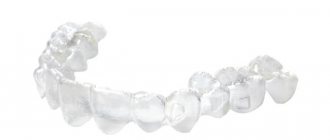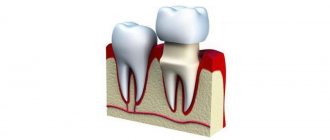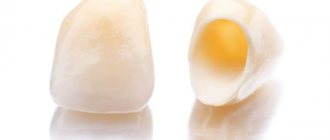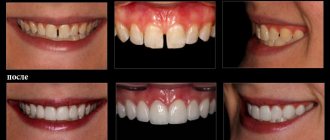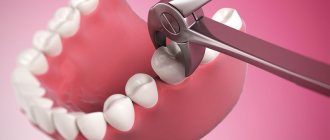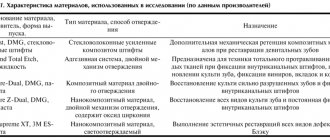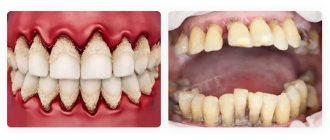- Dental crown - what is it?
- Types, materials, manufacturing methods and photos of dental crowns
- Time and stages of making dental crowns
- Lifespan of dental crowns
- How to best prepare for a visit to a dentist or orthopedist
- Before visiting an orthopedic dentist
- At the dentist's appointment
- After prosthetics
- Which crown is better - metal-ceramic or zirconium?
- Common questions from clients
- About cheap dental crowns, advice
Dental crowns in our clinic
Specialists from the Beryozka clinic will help you place strong dental crowns based on an individual impression. Our doctors work according to the most modern treatment protocols, which ensures maximum similarity of the artificial crown with the real one. High-tech materials ensure long-lasting wear even with intensive use of the crown.
Making a crown based on an individual impression ensures the most comfortable use. And budget prices allow you to restore the beauty and functionality of the jaws to a person with any income.
Free consultation!
You can get acquainted with the specialists of the Beryozka clinic and decide on the need to install a crown at a free consultation. Our doctors are confident that the patient, once in their hands, will definitely return for treatment. This is facilitated by the beautiful and comfortable environment in the offices, friendly and polite staff, as well as the high professionalism of the dentists.
What is a dental crown
The visible part of a natural tooth is the crown. It is most often destroyed due to caries, trauma or the process of demineralization. It can be restored with an artificial prosthesis - a dental crown. It can be temporary - for the period of treatment, or permanent - for every day. In some cases, crowns are used to correct the shape of implants when they are damaged.
Prices
| Primary appointment (examination, consultation) with an orthopedic dentist | 1,150 rub. |
| Repeated appointment (examination, consultation) with an orthopedic dentist | 100 rub. |
| Tooth restoration with a temporary crown using the direct method | 2,500 rub. |
| Tooth restoration with a permanent crown (CEREC method) | 32,000 rub. |
| Tooth restoration with a permanent metal-free crown “Imax” with individual aesthetics (application method) | 35,000 rub. |
| Tooth restoration with a permanent metal-free ceramic milled crown | 28,000 rub. |
| Tooth restoration with a permanent metal-ceramic crown | 15,000 rub. |
| Tooth restoration with a permanent all-metal crown | 6,000 rub. |
| Restoring a tooth with a crown using a solid core inlay | 7,000 rub. |
| Restoring a tooth with a crown using a solid core inlay. Stump inlay made of zirconium dioxide | 15,000 rub. |
| Tooth restoration with a crown. Combined tooth. Metal-ceramic crown on an implant | 20,000 rub. |
| Trephination of tooth, artificial crown | 500 rub. |
Contraindications
Like any medical procedure, the installation of crowns has contraindications. Cases in which the procedure is not performed:
- advanced periodontitis;
- bruxism - teeth grinding;
- fragile enamel;
- teeth are small and poorly positioned;
- pathological bite, when the incisors overlap one another.
Sometimes the age of the patient may be a contraindication to installing a crown made of a certain material. Then he is offered another way to restore the integrity of the dentition.
What are they: materials
Crowns are made from different materials: some are more durable, others are only suitable as a temporary measure. Their cost, complexity of manufacturing and installation also depend on this.
Metal ceramics
The product has a metal frame and is covered with ceramics on top.
| Pros: | Minuses: |
| High strength. | Contraindicated for people under 18 years of age. |
| Aesthetics. | Not suitable for gum recession. |
Metal-ceramic crowns are suitable for installation only in adult patients.
Metal composite
The crown frame is made of an alloy of chromium and cobalt. From above it is covered with a photopolymer composite: while it is soft, it is given a shape, after which it is fixed with UV rays.
| Pros: | Minuses: |
| High strength. | Coloring from products with pigment. |
| Thin and invisible edges. |
People with metal-composite crowns need to follow a diet to prevent artificial teeth from changing color. It is not recommended to consume drinks with dyes and foods with a high pigment content.
Golden
The oldest material for making crowns is gold.
| Pros: | Minuses: |
| Hypoallergenic. | Lack of aesthetics. |
| They do not damage neighboring healthy teeth. | Rapid abrasion due to the softness of the metal. |
It is best to install gold crowns on the back teeth, where they will be almost invisible.
Zirconium dioxide
Modern material for crowns is zirconium dioxide. It is durable, aesthetic, does not cause allergies and lasts a long time. But it has a fairly high cost, so it’s not suitable for everyone’s budget.
Metal-free
Modern synthetic materials can completely replace metal in the composition of the crown. They are no less durable, and look as close as possible to natural teeth.
Ceramic
The best way to choose the color of a crown is when it is made of ceramic. They do not look artificial, as they are quite transparent.
They are great for replacing incisors. But for chewing teeth, ceramic crowns are too fragile and cannot withstand such a load.
Porcelain
Porcelain crowns are not so popular, but are gradually becoming more and more in demand. They are easily and firmly fixed, which reduces the risk of loosening. Porcelain products last a long time, do not deteriorate due to temperature changes and are not stained by food. In this case, the crown can be made in an anatomical shape, repeating the relief of the tooth as accurately as possible, which ensures comfortable wearing. They look very aesthetically pleasing and are also hypoallergenic.
One of the disadvantages is their loose fit to the tooth, which can cause cervical caries. Crowns are quite fragile and can destroy adjacent healthy teeth. The product is not suitable for patients with thin enamel. In addition, the cost of such crowns is quite high, which is not affordable for everyone.
Combined
By combining several materials, it is possible to create crowns that combine their best properties. The product is suitable for use on front and back teeth: they look aesthetically pleasing and can withstand chewing loads. But such crowns are short-lived because they quickly wear out and sometimes become deformed. But their installation does not cause a blow to the budget.
Plastic
Plastic crowns are used as a temporary measure. They are manufactured on site and installed on the same day in place of the extracted or treated tooth. The cost of such crowns is low. But it is impossible to use them as permanent ones, since they cannot withstand prolonged chewing load.
Metal ceramics
Porcelain crowns
A very common material for dental prosthetics . In the process of manufacturing metal-ceramic crowns in “22nd century” dentistry, metal frames are used from a cobalt-chromium-molybdenum alloy (Heraenium P), a titanium-based alloy (REMATITAN), and a special alloy (gold-platinum).
The one-piece frame of such crowns is lined with ceramics. The metal base and the top coating of medical porcelain give the crowns the characteristics that the dentistry of our grandmothers' times could only dream of. Naturally, you cannot bite nails or uncork bottles with metal-ceramic crowns. However, only those who want to part with them quickly use their natural teeth for these purposes.
Types of crowns
The number of missing teeth, the presence of dentures and other individual characteristics of the patient determine what type of crown is suitable for him. It is impossible to determine this in absentia, since it requires an examination by a specialist.
Bridges
Suitable for people who have lost more than one tooth. The prosthesis is made for all missing units, and its parts are connected by a metal bridge. To secure the crowns, you need healthy chewing teeth. Only complex prosthetics are performed in this way.
Implant supported crowns
If the patient has implants, the crown can be secured to them. This will prevent the destruction of healthy teeth, which can occur due to excess stress. But the method is only suitable for those who already have implants installed.
Crown for one tooth
If one tooth is destroyed, a crown can be installed only on it. This usually happens after deep caries or injuries. Before installing a crown, the condition of the periodontium, jaw and gum tissue is assessed. Sometimes additional operations are performed to build up the bone plate.
Fixation with a pin
The rarest method of prosthetics is installing a crown on a pin. It is quite traumatic and carries a risk of complications, so it is almost never used. If other methods of prosthetics are not available to the patient, the crown is installed on a pin, but this is done in several stages under the supervision of specialists at each of them.
Classification:
By purpose:
- Restorative;
- Abutment (used in bridges ; they replace not only a defect within the coronal part of a tooth, but also a missing tooth or several teeth).
By design features:
- Full (cover the prepared stump from all sides), partial (three-quarter, half-crowns) leave the outer surface of the crown open;
- Telescopic (double; used in removable prosthetics, the first cone-shaped is fixed on the stump, the second, restoring the tooth, is part of the removable part and is put on the first).
According to the material used:
- Metal (noble or base alloys);
- Non-metallic (ceramics, zirconium dioxide, plastic, composite);
- Combined (metal-ceramics, metal-plastic).
By fixation method:
- Cemented (for prosthetics of natural teeth or on implants);
- Screw (used only for prosthetics on implants - artificial analogues of natural roots, strengthened inside the bone tissue of the jaws).
By service life:
- Permanent;
- Temporary - provisional (used at the stages of manufacturing the final ones to protect the stump from irritants, restore contacts with other teeth and for aesthetic purposes, including to form the contour of the gums ).
Methods for making a crown
Orthodontic products can be manufactured using several methods. Each of them has its own advantages and disadvantages.
Cast products
Strong and durable crowns are made using casting. For this, a single piece of metal is used. The method is not suitable for all materials.
Stamped
More affordable, but less durable prostheses are made by stamping:
- a mold is placed into the dental anvil;
- using rubber rings a stamp is obtained;
- the crown is made using special hammers that differ in shape and size;
- The product is given its final shape using small tongs.
Such crowns last less than cast ones, but are much cheaper to produce.
A laboratory technician performs the following manipulations:
Making diagnostic models of jaws
- Making diagnostic models of jaws;
- Making temporary crowns (if they are not made directly by a doctor in the office using a silicone key - a special material is applied to the area of interest and retains its shape when hardened); as a rule, the help of a technician is required in case of severe initial destruction - in this case, he casts a model using an impression, models the damaged areas on it with wax, and from this structure, using a key, makes temporary restorations;
- Making working models from supergypsum based on final impressions;
- Making a wax reproduction of the final restoration followed by a step-by-step replacement of materials (for example, casting a base for a combined structure, followed by application and firing of ceramic mass).
In addition to the traditional manufacturing method, there is also the so-called milling from ready-made blocks on a computer-controlled machine (CAD/CAM technology, for example CEREC, EVEREST). Using an optical system, an impression is taken (essentially scanned) either of the prepared area directly in the oral cavity, or of a model, then the data is transferred to a computer, where the image is processed by a special program, a model of the future restoration is built, which can be corrected, and then sharpened and finalized ( painted and glazed to give a shine comparable to natural). Now this is the most accurate way to create structures of various sizes and lengths (up to the entire dental arch), because human involvement and therefore possible inaccuracies are reduced to a minimum. The next step will obviously be the development of 3D printing technologies.
How a tooth crown is made
Before starting to make the prosthesis, the size and shape of the product are determined. To do this, the patient undergoes:
- examination by a doctor;
- general and targeted x-ray diagnostics;
- 3D - visualization on a computer screen of the entire jaw and a specific tooth.
Then the doctor selects the material from which the crown will be made. It depends on which tooth needs to be replaced, the age of the patient and his financial capabilities.
To accurately manufacture the prosthesis, an impression of the jaw is taken. For this, gypsum or a similar synthetic material is used. The resulting model is sent to the laboratory.
Preparing for installation
A crown cannot be placed on an unprepared tooth. He must be completely healthy. If you have inflammatory diseases of the oral cavity, they need to be cured before installing a crown.
Then the teeth are ground down. It is performed under anesthesia, so the patient does not experience any discomfort. This procedure is carried out to ensure that the denture fits perfectly and no food remains get stuck under it. It also allows you to equalize the width of the neck and middle of the tooth. This way the prosthesis will be firmly fixed, which will prevent loosening.
Only 1-2 mm of enamel is removed. The depth of treatment depends on the selected crown material: metal-ceramics require more space, and ceramics are quite thin; a very thin layer is removed to install it.
In some cases, depulpation is performed. The patient is warned about its need in advance.
If the tooth is severely damaged, a core inlay is installed. It separates the internal tissues from the crown, allowing you to avoid pain while wearing it.
Upon completion of all manipulations, a temporary crown is installed on the tooth. It is made in the dentist's chair. The design protects the prepared area and restores its aesthetic appearance.
Features of care
Teeth with crowns do not require special care. But the patient should not forget about maintaining hygiene at the proper level. It is necessary to brush your teeth at least twice a day and rinse your mouth with bactericidal solutions. You should also follow simple recommendations:
- do not allow strong temperature changes in the oral cavity;
- do not test the strength of artificial teeth by trying to bite through nuts and other hard objects;
- carry out professional cleaning at the dentist at least once every 6 months;
- limit the consumption of coffee, strong tea, and sweets.
Installation process
The crown is installed in several stages. The number of visits to the doctor depends on the condition of the teeth and the chosen prosthetic method.
Laboratory stage
A cast of the patient's jaw is sent to the laboratory to create a plaster model of the jaw. After complete drying, the desired part is cut out. Using it, a wax prototype is made.
The model is fixed on the base and filled with a special mixture. It goes into the oven for 4-5 hours. The resulting mold is immediately filled with the alloy while it is hot. The future crown is left in this form until it hardens completely. The piece is then polished and sanded to achieve the perfect shape.
Removing the temporary structure
When the permanent crown is ready, the temporary structure is removed. It only takes a few minutes, after which prosthetics can be applied.
Installing a crown on a tooth
Before fixing the crown, a fitting is performed. If it is uncomfortable or the enamel color is not suitable, it is sent for revision. When the crown is perfect, it is secured with cement. The strength of the fixation must be checked after the material has hardened.
Monitoring the situation after installation
After fixing the crown, the doctor checks how correctly it is installed. To do this, an x-ray is taken. Only after his assessment can the patient go home. If you experience strange sensations, you should call your dentist to clarify your condition and the need for a second visit.
Our advantages
At the Beryozka clinic, the material for the crown and its type are selected individually. Each patient is given an approximate treatment estimate so that he can clearly see what he is paying for. A transparent work system, professionals, the latest equipment and materials ensure the ideal result of prosthetics at the Beryozka clinic. A polite attitude and the ability to quickly get an appointment are the key to pleasant emotions from visiting a dentist.
Pros and cons of crowns
All medical procedures have both pros and cons. Before you decide to install crowns, you should compare the pros and cons.
Advantages
The advantages of using this method of prosthetics are much greater than the disadvantages. The advantages of installing crowns include:
- preventing the destruction of pulpless teeth;
- preservation of a living tooth even with partial destruction;
- restoration of the ability to chew food normally;
- restoration of an aesthetic appearance while smiling;
- prevention of diseases of the gastrointestinal tract, which can be caused by insufficient chewing of food;
- restoration of the ability to speak clearly.
Due to the large number of advantages, the procedure has become so popular among patients.
Flaws
The procedure for installing crowns has its disadvantages. Flaws:
- the need to grind healthy parts of the tooth;
- limited period of wearing a prosthesis;
- inability to carry out the procedure with a damaged root;
- the need for regular visits to the dentist for monitoring.
The disadvantages of the procedure are offset by its advantages. Therefore, crowns remain the most popular way to restore the integrity of the dentition.
